Analysis
This California Museum Had Big Ambitions—and Then Shuttered. Here’s What It Teaches Us About the Perils of Private Museums
The Main was founded by a local developer to serve as a beacon of creativity in downtown Los Angeles.
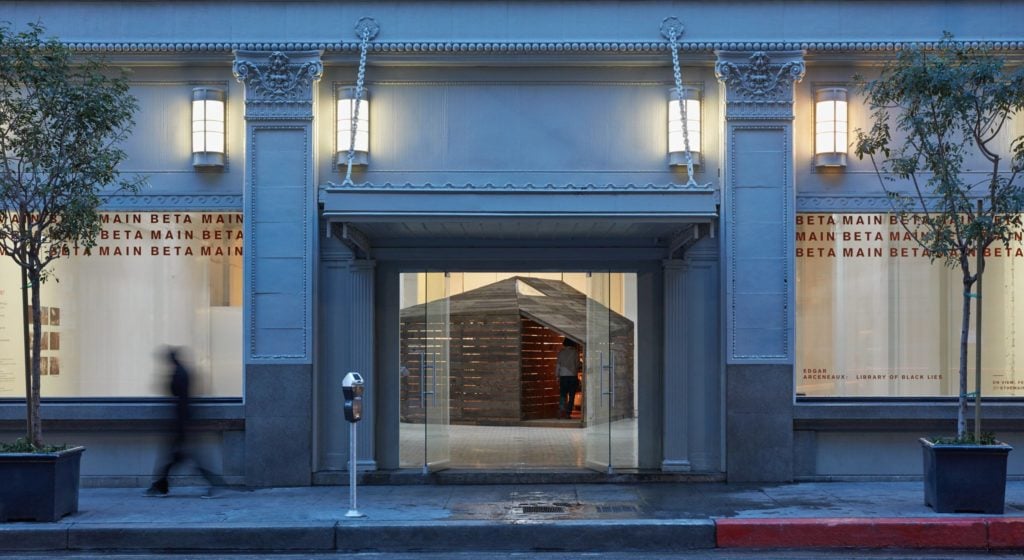
The Main was founded by a local developer to serve as a beacon of creativity in downtown Los Angeles.

Catherine Wagley

What causes a museum—especially one that had hired high-profile staff, commissioned a $53 million redesign, and espoused a forward-thinking mission—to implode?
This is the question behind the rise and fall of the Main Museum, a non-collecting, nonprofit contemporary space that opened in downtown Los Angeles in 2016. Last month, the stately Beaux-Arts building that formerly housed the institution reopened as ArtCenterDTLA under new leadership. The developer Tom Gilmore, who founded the museum and owns multiple surrounding properties, has agreed to lease the building to the Art Center College of Design for $1 per year, walking away from his former vision for a cutting-edge contemporary art museum.
It was not supposed to be this way. When the Main first opened, Gilmore said he hoped it would “be a cultural anchor in the neighborhood.” But just over two years later, the museum’s director and all remaining core staff resigned.
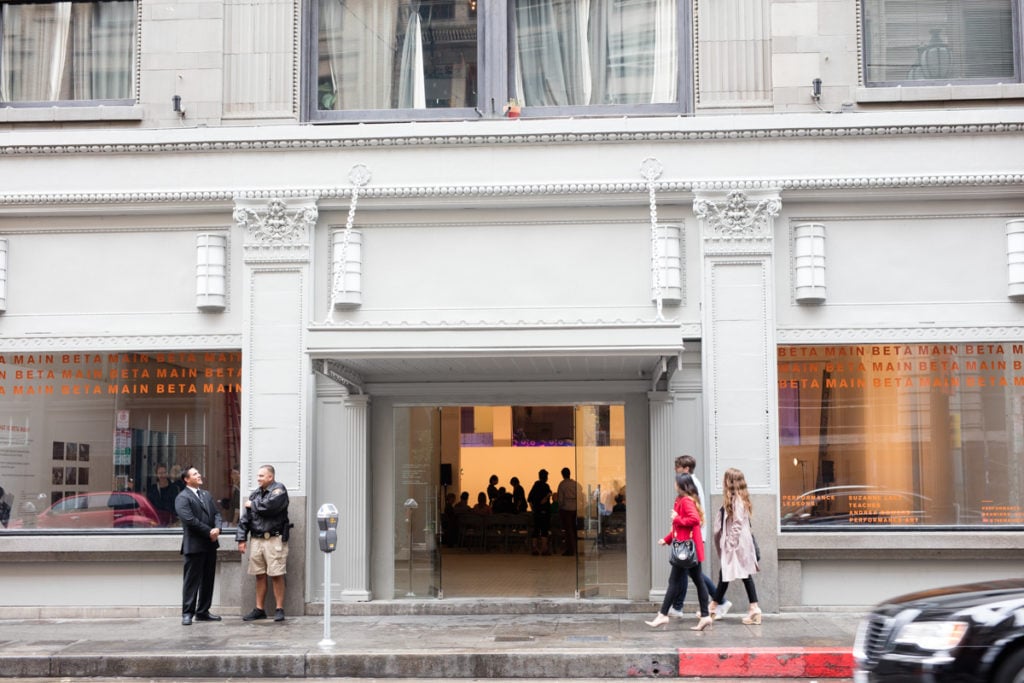
The facade of the Main Museum in downtown Los Angeles. Courtesy of the Main Museum.
The abrupt closure seemed, from the outside, mysterious. Gilmore did not comment—his assistant said in January that he would “provide comments about the museum next month” and then, in February, stopped responding to queries. The Main’s founding director, Allison Agsten, offered only a vague explanation, saying that she “didn’t see a clear path forward for me and the work that I’m most devoted to.”
As an institution meant to simultaneously further downtown’s cultural cachet and celebrate social practice and civic engagement in a gentrifying neighborhood, the Main’s political and curatorial ambitions were conflicted from the start. But because of its failure, it reveals more than usual about the perils and potential abuses of art institutions founded by developers and other museum management novices with motives beyond simply sustaining and supporting art.
When plans for the museum first became public in 2014, Gilmore described it to Curbed LA as “a repository for prominent downtown artists of the last 40 years.” It would also serve as a culmination of the developer’s decades-long effort to revitalize the surrounding blocks.
The Main arose at a prime moment for the development of art institutions in Los Angeles, particularly those fueled by private money. Billionaire Eli Broad’s museum would soon open just north on Grand Avenue (though Gilmore later made a point of differentiating himself from Broad, telling KCET, “I’m not a fan of naming buildings after yourself”). Hauser & Wirth would open its kunsthalle-style Arts District complex in 2015, and the ICA LA would follow nearby in 2017.
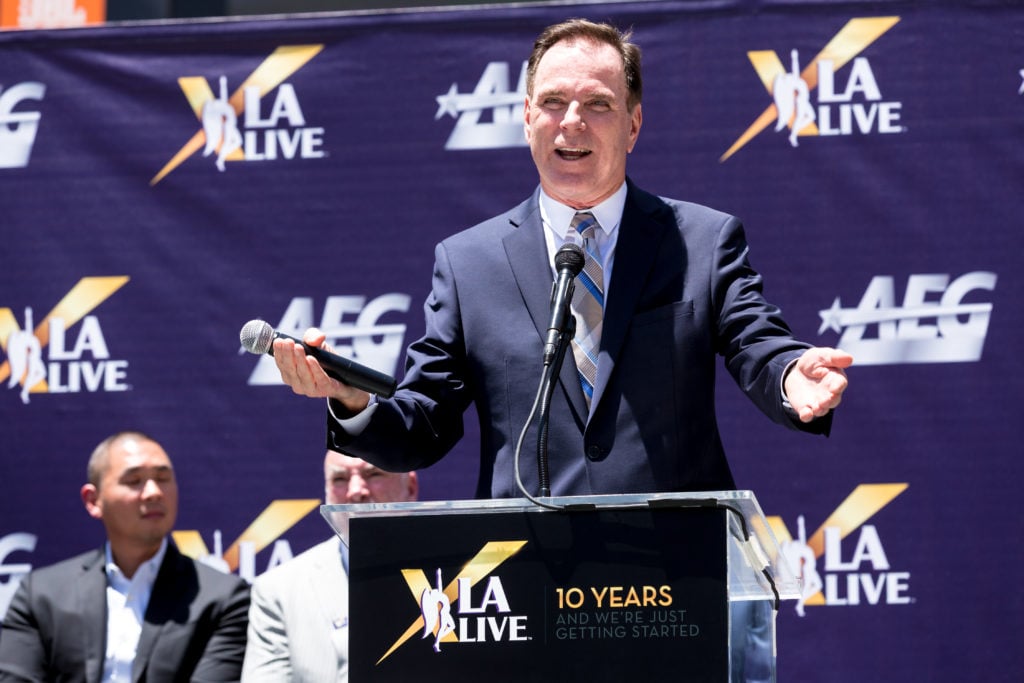
Tom Gilmore, President, Central City Association attends L.A. LIVE Celebrates 10th Anniversary on June 8, 2018 in Los Angeles. (Photo by Greg Doherty/Getty Images)
Gilmore, one of the earliest developers to use LA’s late-1990s adaptive reuse ordinance to restore downtown buildings, incorporated art into his real estate vision early on. For years, he had been leasing storefronts in the buildings he developed to galleries. He was also a staunch promoter of the downtown art walk, albeit a controlling one (ensuring the event ended and began near his properties). He began buying downtown buildings in 1999, using a $27.5 million loan backed by a previously discontinued federal redevelopment project.
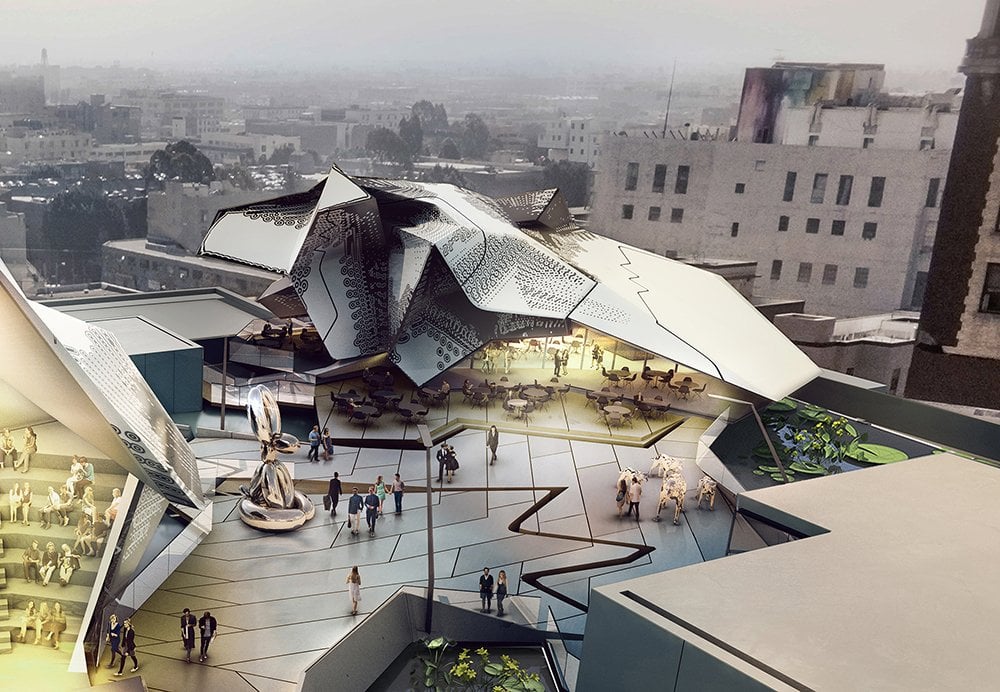
Rendering of the never realized Main Museum. Courtesy of Tom Wiscombe Architecture.
“No one quite understands how Tom Gilmore got this federal money that everyone thought was already gone,” said preservationist Richard Schave. But bending reality to fit his ambition became part of Gilmore’s mystique. Contractor Frank Gamwell, who sued the developer for unpaid labor in 2001, told Los Angeles Magazine, “[E]veryone is giving away a little bit of their life, a little bit of their money, to keep his myth going.”
By the mid-2000s, Gilmore’s gamble began to pay off, and galleries occupied the first floors of three of his buildings. Don Spivak, former deputy chief of LA’s Community Redevelopment Agency, said that, for Gilmore, “things like the art walk and the related galleries, the creation of gallery row, was a way of branding the neighborhood.”
Once a neighborhood has high-end restaurants, lofts, and galleries, few things underscore its cultural significance better than a new contemporary art museum. In March 2015, architect Tom Wiscombe completed his schematic for the Main, which looked like a spaceship hovering over and invading parts of the historic bank buildings. Beta Main—the name for the pre-renovated space—opened in September 2016 with an ambitious program curated by the museum’s director Allison Agsten, the former curator of public engagement at the Hammer Museum.
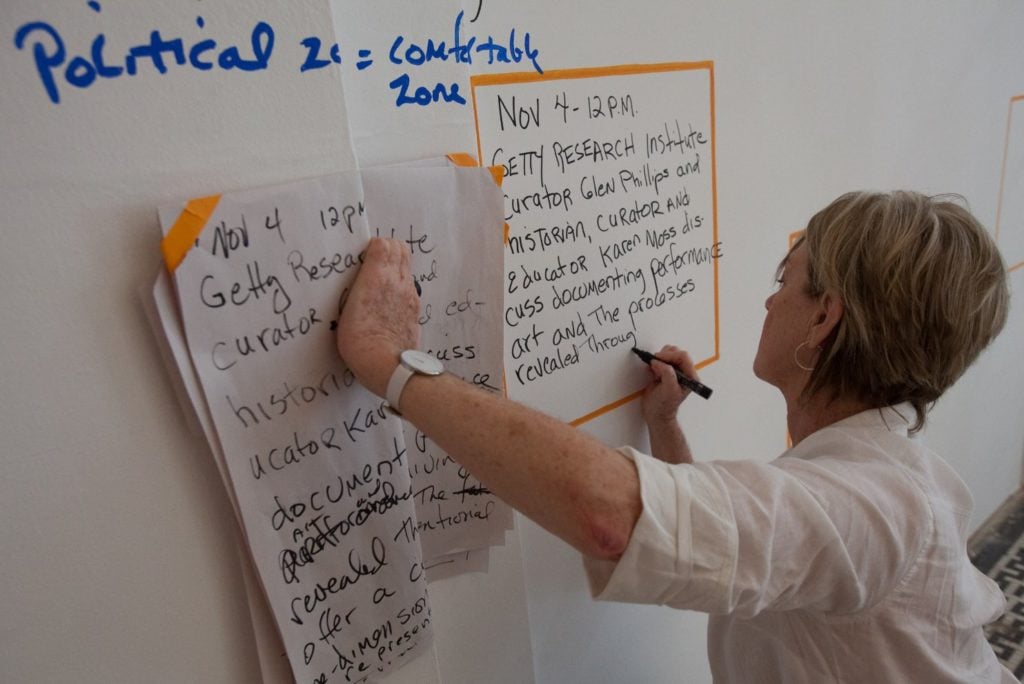
Artist Suzanne Lacey at work in the Main Museum during her residency.
For ten days, artists Suzanne Lacey and Andrea Bowers lived in the museum offices for a project called Performance Lessons. Lacey endeavored to teach Bowers performance art during the residency, hosting workshops and talks in the space. “I dare say this could be a monumental work,” Agsten said at the time.
This inaugural program culminated on November 8, election night. Early in the evening, Bowers optimistically hung Trump piñatas from the ceiling. But the artists in attendance ended up spending the night tearfully discussing how to respond to Trump’s victory. This beginning summed up the Main’s lot pretty well: an institution trying to be relevant and progressive as other agendas and circumstances undermined these goals.
Two years later, after Agsten, deputy director Alex Capriotti, and curator Monica Rodriguez resigned together, Agsten asserted via email that “Tom stood by [the] vision” to “create a program that was in direct response to this moment in Los Angeles.” But for a few days in December 2018, right after the group resignations, the Main’s Instagram bio read “Cancelled,” suggesting passive aggression from at least someone on staff.
Still, turning this into a story about one developer’s mismanaged foray into museum-running would oversimplify a narrative with broader implications for an art world where misguided ambition and desire for cultural capital often disproportionately affect less powerful art workers and artists.
Those who worked at or with the Main, some of whom spoke on the condition of anonymity, recounted an institution whose internal culture was increasingly at odds with its purported vision, whose fundraising was precarious, and whose work environment was emotionally demanding and defined by uncertainty.
“I think the way a lot of people see it, is that the museum failed due to Tom’s broken promises and Allison’s subsequent struggle to steer this ship, but that isn’t the full picture,” said Cat Yang, a project assistant at the Main through May 2017. Yang began working as an assistant to both Agsten and Gilmore before the museum opened, and watched as they negotiated early plans. “There were a lot of struggles between their two visions, because they also have a different appreciation of art. His was much more architectural and hers was much more contemporary.”
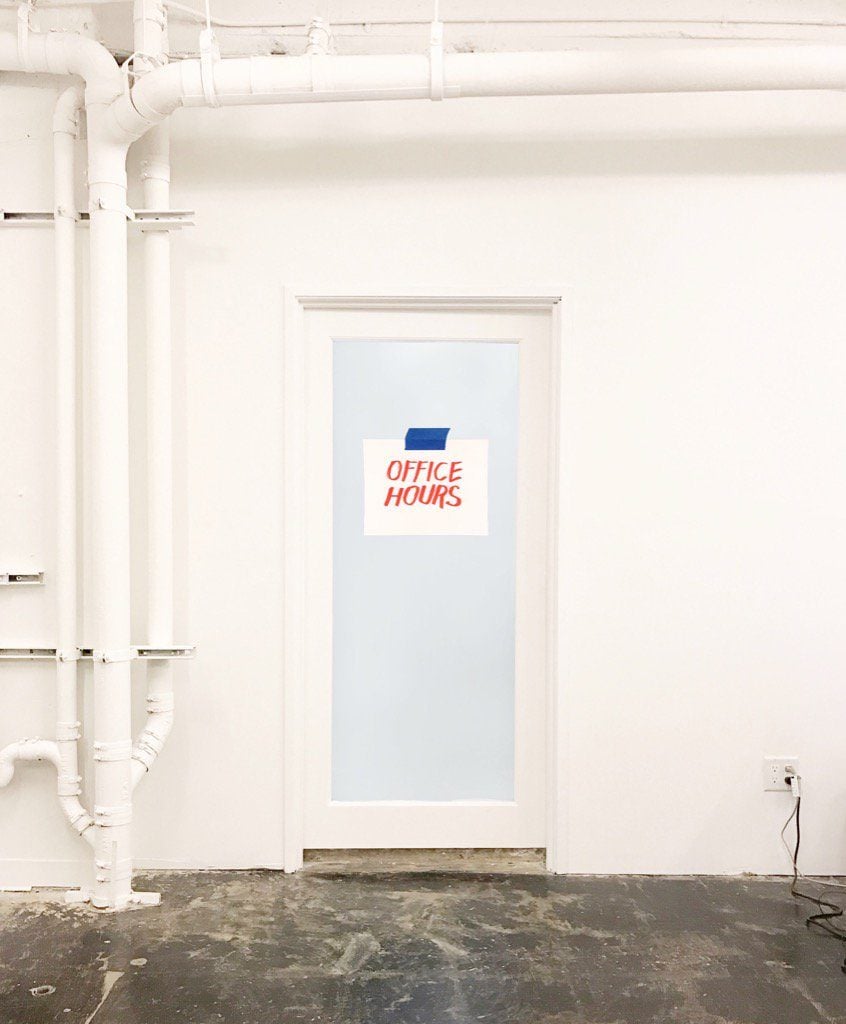
Image courtesy of the Main Museum.
From the start, the Main professed an interest in supporting downtown residents of every ilk. One program, Office Hours, specifically welcomed local artists to meet with Agsten one-on-one. Molly C. Meng, who has a studio near the museum, recalls Agsten asking her and her collaborator “what we would like to see more of in the community downtown.” She added, “That concept”—of a gallery or museum engaging its direct neighbors—“doesn’t exist a ton.”
But the Main’s community-oriented ethos seemed at odds with its internal culture. A few days into operation, Gilmore asked the staff to refrain from making political statements of any kind. In early 2017, he also sent out an email to all his staff, asking them to vote against the Skid Row Neighborhood Council, a group formed by residents that would oppose the more business-friendly Downtown Los Angeles Neighborhood Council, where Gilmore has long been influential. (In 2005, the developer told scholar Bernard E. Harcourt, “On some level the existence of poor and potentially homeless people or borderline people is not antithetical to a healthy urban environment.”)
Employees who spoke to artnet News also criticized the museum for its treatment of both staff and resident artists. One artist-in-residence left the program early when she realized she would not receive a sustainable stipend. Yang found her position eliminated in May 2017, soon after she says she spoke out against the treatment of resident artists, many of whom were artists of color without independent financial resources. (The Main announced in July 2017 that it would begin to offer each resident artist a studio and $1,000 per month.) Yang also reported that she worked without time off for over two weeks straight in the days leading up to the opening, before she even had a contract for her new position.
Money proved a problem at the Main in multiple ways. Although the museum hired a development advisor in 2016, Gilmore continued to be the leading funder through December 2017. Then, according to former staff members, Gilmore, who had no contractual responsibility to the Main, stopped funding the museum altogether. (Asked for comment on this decision, Gilmore said, through his assistant, that he was out of the country and unavailable.)
Agsten promptly began looking for a university partner, hoping the museum could operate under its umbrella in the way the Hammer operates under UCLA. In May 2018, ArtCenter and the Main announced an “exploratory partnership.” The Main Museum, as a nonprofit, had no lease from Gilmore, but he ultimately offered to negotiate a lease to ArtCenter.
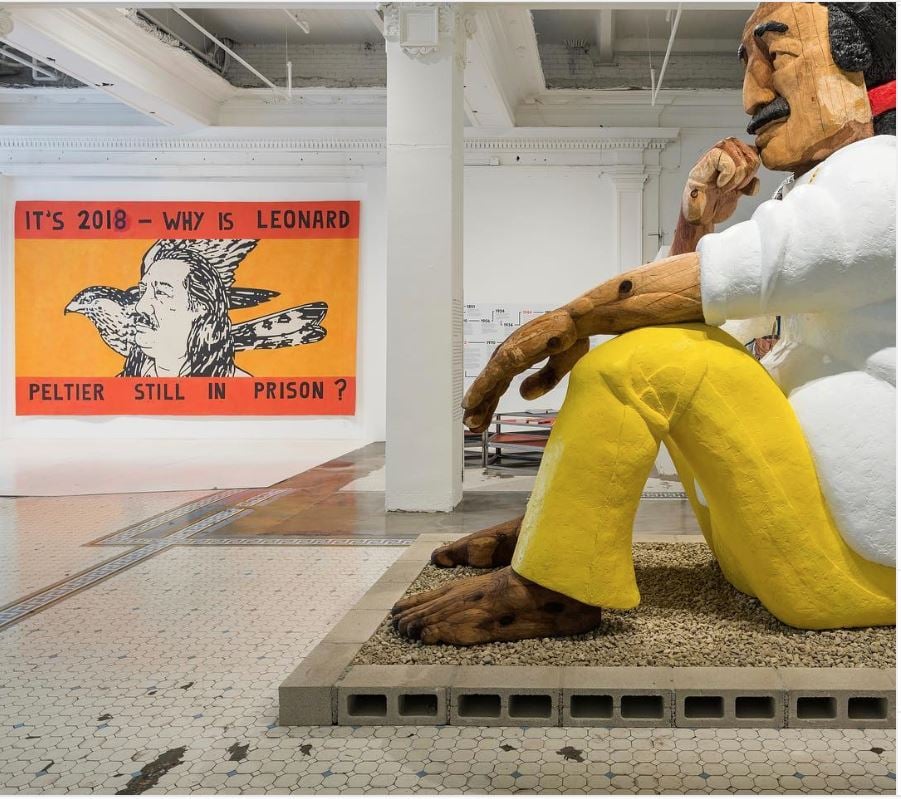
Statue of Leonard Peltier at Beta Main, 2017. Courtesy of the Main Museum.
Although Agsten had reportedly hoped that the school would choose to support the museum’s ongoing operation, the Main’s final exhibitions closed in May 2018. One work on view, a larger-than-life sculpture of imprisoned Native American activist Leonard Peltier by Rigo 23, had previously been removed from view by American University in Washington, DC, following complaints. The artist wanted to reinstall it at an institution that represented some version of civic and financial power.
Rigo 23 was diplomatic about his experience at the Main, but acknowledged that cultural nonprofits like it are “too vulnerable to the machinations of the super-rich.” He added, “I think we’ve experienced enough failures with this individual-over-collective model, we might as well experiment with other types of failure.”
ArtCenter has assembled a committee of faculty and administrators to determine how the school will use the space long-term. Regardless of what they devise, the school already has funding and an institutional identity, making it a safer element in Gilmore’s downtown empire than a purportedly progressive but untested nonprofit.
Cat Yang now sees her experience at the Main as indicative of larger problems. “Many nonprofit art professionals work and live in precarity,” she said. “That precarity is determined by people in power who refuse to address it or even acknowledge it.”